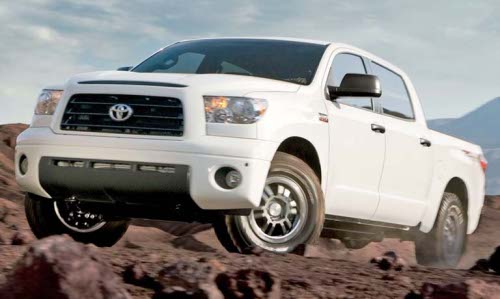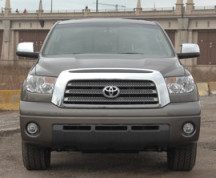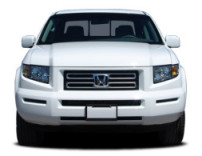2009 Tundra More Of The Same
Yesterday Toyota used their Open Road blog to announce some changes to the 2009 product line-up. The Highlander is getting a new 4cyl, the 4Runner Trail edition is coming out, and headlining the blog post are changes to the Tundra:
- Select regions of the US will offer flex-fuel versions of the 4×4 5.7L Tundra
- There will be a new “TRD Rock Warrior” package with a black and white color scheme and a tuned off-road suspension
- There will be a new “TRD Sport” package with a red and black color scheme
In other words, not much is changing for the 2009 model year. The 2010 model year, however, is going to be a different story altogether. We believe Toyota will debut a complete update to the truck (slightly more hp and torque, a re-skin, minor improvements, etc.) along with a new engine choice, the 4.5L Tundra diesel.
The new Tundra TRD Rock Warrior package with the black-and-white color scheme.
Honda Ridgeline vs Toyota Tundra
The differences between the Honda Ridgeline and the Toyota Tundra demonstrate the fundamental difference between the understanding each of these Japanese manufacturers has of the North American truck market. After spending decades selling mini-trucks and three-quarter size versions of their domestic competition’s pickups, Toyota decided to target the not-so-big three and develop a full-size pickup that was every inch the equal of the perennial class-leading F150 and Silverado. The Tundra has been a definite success in that regard, even surpassing the competition out of Detroit in terms of certain features and capabilities.
Honda, to put it mildly, decided to go another route. With no history of selling trucks in the United States, the Ridgeline appeared out of nowhere as a sort of combination pickup truck / SUV hybrid that claimed to be a full-size truck but fell short in several crucial areas – most notably horsepower, towing capacity and, well, size. In terms of exterior dimensions, the Ridgeline follows the old Toyota game plan of trying to offer big features with a small footprint. Sadly, in the minds of truck buyers, the length, width and height of a vehicle make a difference, and when seen side by side the Ridgeline is clearly dwarfed by the Tundra.
Here’s an approximate proportional view of the Tundra and the Ridgeline side by side.
Honda has chosen to outfit the Ridgeline with only one engine choice, a 3.5 liter V6 which is rated at 247 horsepower. Not only is this a full 120 horsepower less than the available 5.7 liter V8 in the Tundra, but historically, pickup trucks have offered a wide range of drive train choices in order to satisfy the individual needs of buyers. Both vehicles offer variable-valve timing in order to improve fuel consumption, yet the Toyota’s 13 miles per gallon in city driving and 17 miles per gallon on the highway compare favorably with the Ridgeline’s 15 / 20 rating – especially when you factor in the 2 extra cylinders and 50 percent greater available power. The Ridgeline also has a smaller box and less than half the towing capacity of the Tundra.
It seems obvious that the Honda Ridgeline is not a serious player when it comes to the full-size pickup truck game. So what exactly is it? Well, to put it simply, the Ridgeline is a pickup truck for people who don’t buy pickup trucks. With its vast array of storage compartments and locking “trunk,” it’s a mini-Chevrolet Avalanche. With an independent rear suspension and smaller dimensions, it’s the kind of truck that won’t intimidate drivers moving up from a Honda SUV. In this sense, it is quite successful – the driving characteristics are more similar to a crossover than a pickup, yet it offers a degree of cargo storage that isn’t found in any other Honda sport-utility vehicle. The ride height lets buyers feel more confident on the road, and the four-wheel drive system adds an air of legitimacy to the entire package.
The Tundra and the Ridgeline are clearly not competing for the same share of the market. In fact, it’s not really easy to see if the Ridgeline has any competition at all in the niche that Honda has carved out for the vehicle. Full-size truck buyers will most likely steer clear of the Ridgeline based on its specifications alone, but it could definitely hold some appeal to those in the mid-size segment, or anyone wanting to fulfill their fantasy of pickup truck ownership without having to extend their driveway or find a bigger parking spot at work.
Toyota Tundra Rated Best Deal For September 08
Intellichoice, a company dedicated to providing vehicle ownership cost estimates and value analysis, provides a monthly “Best Deal” list for new car buyers.
For September 2008, the Toyota Tundra is a listed as the best deal in the 1/2 ton, 2wd category. Were it not for the fact that Lincoln is giving away the discontinued Mark LT, the Tundra might be the best deal overall in 1/2 ton trucks.
Intellichoice’s “Best Deal” designation is determined by current car prices, market conditions and the lowest national manufacturer consumer new car rebate. In addition, IntelliChoice.com uses the latest information from numerous automotive resources to evaluate what it costs to buy, own and operate each new car model-year trim line over a five-year basis.
So in other words, the Tundra is the best deal not only because of rebates, but because it’s expected to be the lowest cost 1/2 ton truck option over the next 5 years.
Not bad.
Car and Driver Long Term Tundra Review
Car and Driver published their long-term review of the Tundra a few days ago, and we thought we’d share the highlights:
There were lots of good comments from the review:
- “There were eight scheduled maintenance visits [with] a tab of $628, which…compares favorably with our most recent long-term full-size pickup, a Nissan Titan“
- “our test truck managed the 5000- and 6000-pound loads (flatbed trailer plus car) hitched up by some of our club racers without even breathing hard“
- “the logbook reflected generally high praise for the Tundra
Not So Big Three Need Money From Mom and Dad
At some point in our lives, we’ve all had to ask for a loan from mom and dad. For most of us, that stopped in our teen years. For GM, Ford, and Chrysler, it turns out that the “big bad global economy” is just too much to handle. They need $50,000,000,000 dollars “to make it until next pay-day.”
That’s right – $50 billion dollars in low-interest loans are needed to facilitate investment in “fuel-efficient vehicles.” A loan for “fuel-efficient vehicle technologies” is code for “we need money or we’re going to file bankruptcy and come live in the basement.”
Besides, since when do businesses need help investing in building cars that will actually sell?! GM, Ford, and Chrysler need money so they can build something that consumers want? Let me see if I understand:
1) The not-so-big three surrendered tremendous market share and world manufacturing dominance by building a terrible product between 1970 and 1995, all the while screwing the poor saps that bought their product (mostly the American consumer).
2) The not-so-big three then decide to start closing plants and tossing the American autoworker out on his or her ass between 1985 and the present.
3) The no-so-big three need low interest federally backed loans or they’re going to go under? What happens if they do go under – will the American consumer and/or autoworker have to pay for that too?
Here’s the deal America – it’s time to let one of these not-so-big three bite the dust. No more blind loyalty to an inferior product, no more handouts, no more bailouts, no more loans. Enough.
Learn how to run a profitable business or die – that’s the American way.




